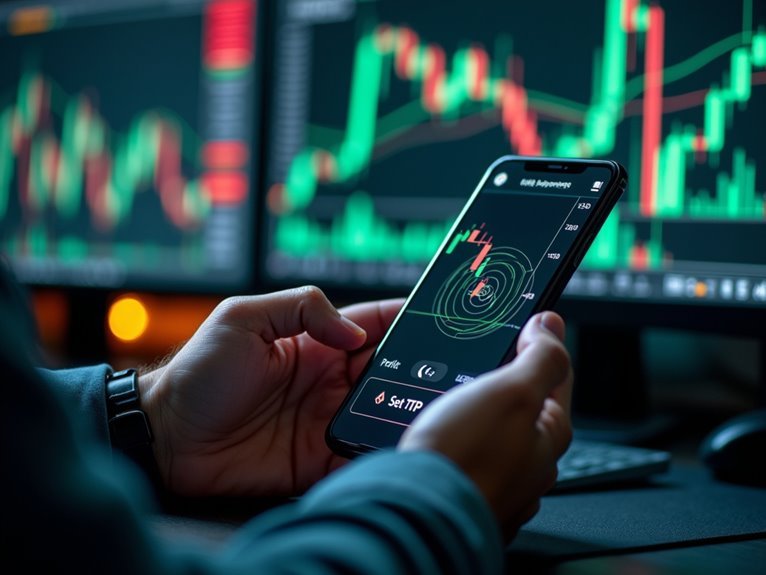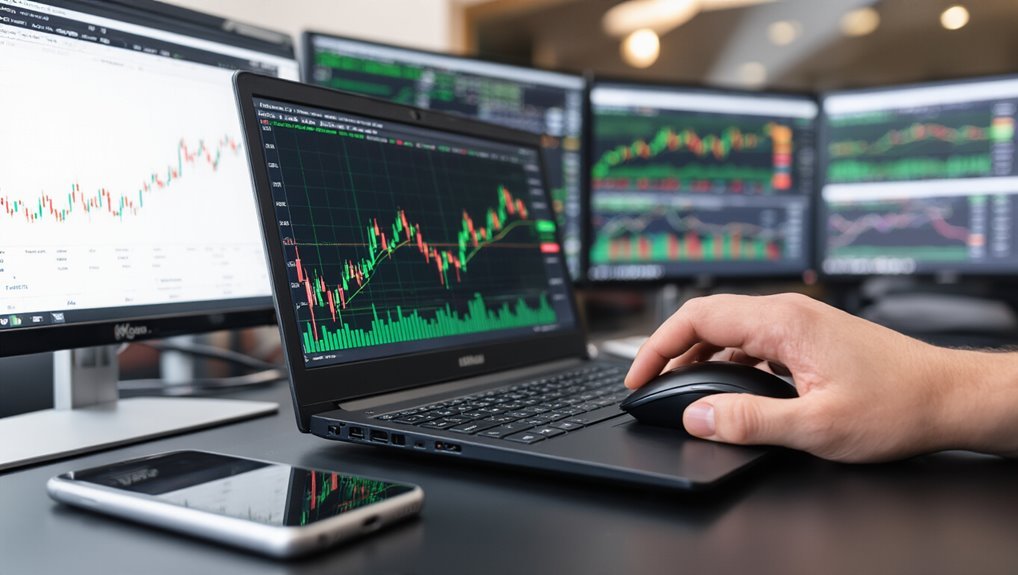TP stands for Take Profit in trading. It’s an automated order that locks in gains when a position reaches a predetermined profitable price level. Traders set TP orders to capture profits without constantly monitoring the market. The order automatically converts to a limit order once triggered, ensuring execution at the target price or better. Unlike stop-loss orders that cut losses, TP orders secure gains before potential market reversals. Understanding TP mechanics reveals deeper trading strategies.
Understanding Take Profit Orders and Their Core Functions

Precision drives successful trading, and Take Profit orders embody this principle perfectly. TP orders are preset instructions that automatically close positions when specific profit targets hit. Simple concept. Powerful execution.
These limit orders wait patiently. They don’t rush like market orders. Instead, they trigger only when assets reach predetermined price levels. Works across all markets—forex, stocks, crypto, commodities. No exceptions.
The mechanics are straightforward. Traders set profit targets based on analysis or risk-reward ratios. The system handles the rest. When price touches the TP level, the trade closes automatically. Volatile markets benefit significantly from this automation as rapid price movements can cause traders to miss optimal exit opportunities. Profits locked in. No manual intervention required.
This automation serves multiple purposes. It eliminates emotional decision-making during live trades. Removes the need for constant market watching. Protects against sudden reversals that could erase gains. The order stays active until triggered, canceled, or manually closed.
TP orders represent disciplined trading at its core. They transform hope into strategy. Successful traders maintain positive reward-to-risk ratios between 2:1 and 4:1 when setting their take profit levels. Strategic placement typically utilizes resistance levels identified through historical trading volume analysis.
Key Differences Between Take Profit and Stop Loss Orders
While both operate as automated exit strategies, Take Profit and Stop Loss orders serve fundamentally opposite purposes in trading. Stop Loss orders cut losses. Take Profit orders lock in gains. It’s that simple.
Two automated exit strategies with opposite missions: Stop Loss protects against losses while Take Profit secures gains.
The execution differs dramatically. Stop Loss typically triggers market orders when prices fall below predetermined levels. This creates slippage risk. Take Profit uses limit orders that execute only at target prices or better. No slippage concerns here.
Placement strategies vary too. Stop Loss placement relies heavily on technical analysis—chart patterns, support levels, reversal points. More straightforward. Take Profit placement proves trickier. Traders must predict trend strength and resistance levels. Risk-reward ratios help guide decisions.
Stop Loss orders suit short-term trading perfectly. Quick exits when things go wrong. Take Profit supports longer-term strategies, letting profits grow before cashing out. Most professionals consider Stop Loss essential for every trade. Take Profit? Sometimes optional, depending on market conditions and trading style. A common approach involves setting a 1:2 risk/reward ratio to ensure potential profits outweigh acceptable losses. Both order types require adequate market liquidity to execute successfully at the desired price levels. These orders help traders avoid emotional decision-making by establishing clear exit points before emotions can cloud judgment during volatile market movements.
Strategic Benefits of Using TP Orders in Trading
Understanding the mechanics between Take Profit and Stop Loss orders sets the foundation for grasping why TP orders deliver distinct strategic advantages. These benefits transform trading from emotional decision-making into disciplined profit management.
TP orders maximize gains by predefining exit points. No more guesswork. Traders secure profits without emotional interference. The automation factor reduces constant market monitoring. Strategic planning becomes possible. Implementing proper position sizing alongside TP orders ensures capital preservation while maximizing growth potential.
| Benefit Category | Key Advantage | Impact |
|---|---|---|
| Emotional Control | Reduces greed and fear | Better decisions |
| Risk Management | Balances risk-reward ratios | Protected capital |
| Market Volatility | Protects against downturns | Secured profits |
Volatility protection proves essential. Markets reverse quickly. TP orders capture gains before potential crashes. Risk reduction happens automatically. Performance evaluation becomes consistent through disciplined profit-taking practices.
The operational efficiency speaks volumes. Time-saving automation allows focus on analysis rather than monitoring. Strategic positioning maximizes gains while minimizing losses. Flexibility remains through adjustable TP levels based on changing conditions. These orders prove versatile across various markets including stocks, forex, commodities, and cryptocurrencies. This structured trading approach encourages discipline by maintaining consistent profit-taking behaviors regardless of market sentiment. Day traders particularly benefit from tighter take-profit levels that match their accelerated trading timeframes.
Real-World Applications and Platform Implementation of TP

Every major trading platform today integrates TP orders as standard functionality. They work across all asset classes. Forex, stocks, commodities, cryptocurrencies. No exceptions.
The mechanics are straightforward. TP orders execute as limit orders when price hits your target. Most platforms let you set these targets during order entry or modify them mid-trade. Many support concurrent TP and stop loss orders. Complete automation.
TP orders function as automated limit orders, executing at predetermined price targets with full platform integration and real-time modification capabilities.
Real traders use them differently. Day traders lock in quick profits on short holds. Position traders align TP levels with technical analysis for longer moves. Forex traders set precise pip targets.
Advanced platforms offer APIs for algorithmic trading. Trailing TP orders adjust upward as markets move favorably. Some platforms provide time-based exits, though these are rare.
The execution varies. Some fill exactly at TP price. Others depend on market liquidity. The key benefit remains constant: removing emotion from profit-taking decisions. No more watching screens constantly. Take profit orders are particularly valuable for traders who cannot monitor trades constantly due to other commitments. When the asset’s price reaches the predetermined level, the order automatically converts to execute the trade.
Frequently Asked Questions
Can I Modify or Cancel a TP Order After It’s Placed?
Most trading platforms allow traders to modify or cancel TP orders after placement. Users can adjust price levels before execution occurs. Some brokers require canceling the existing order first, then setting a new one. Changes must happen before the market hits the target level. Once triggered and executed, modifications become impossible. Platform interfaces typically offer direct editing through trade management windows.
What Happens if My TP Order Doesn’t Get Filled?
If a TP order doesn’t get filled, traders face several scenarios. The position remains open, exposing them to continued market risk. Price might reverse direction, potentially turning profits into losses. Market volatility or thin liquidity often causes missed executions. Technical issues can also prevent fills. Traders must monitor positions actively and consider adjusting targets or using alternative exit strategies to secure gains.
How Do I Calculate the Optimal TP Level for My Trades?
Traders calculate ideal TP levels using risk-to-reward ratios, typically 1:2 or 1:3. They multiply their predetermined risk by the reward ratio, then add it to entry price for longs or subtract for shorts. Technical analysis helps identify realistic targets through resistance levels, Fibonacci extensions, and moving averages. Market volatility, measured by ATR, adjusts TP distance. Timeframe matters—short-term trades need tighter targets than long-term positions.
Are There Any Fees for Placing TP Orders?
Most brokers don’t charge separate fees for placing take profit orders. Standard trading commissions and spreads apply when the TP order executes, not when placing it. ECN brokers typically charge small commissions per completed trade. Market makers work fees into spreads. Some platforms may impose rare exceptions for advanced algorithmic features. Modification or cancellation of pending TP orders generally costs nothing.
Can I Set Multiple TP Levels for One Trade?
Yes, traders can set multiple take profit levels for a single trade. Most platforms allow up to 8 separate TP targets. Position size gets divided proportionally – maybe 30% at TP1, 30% at TP2. This strategy captures profits incrementally while reducing risk exposure. Technical levels like Fibonacci retracements guide placement. Partial closures lock in gains early while keeping some position open for further upside potential.
Conclusion
TP orders serve as essential risk management tools for traders seeking consistent profit realization. They eliminate emotional decision-making while ensuring gains are captured at predetermined levels. The automation aspect proves particularly valuable during volatile market conditions. Understanding the distinction between TP and stop-loss orders enhances overall trading strategy. Most platforms offer straightforward TP implementation. Smart traders integrate these orders into extensive risk management frameworks for improved long-term performance.



